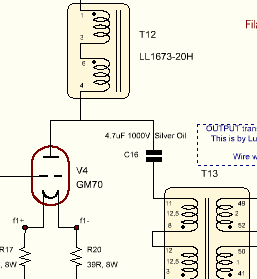Parafeed Amplifier
Who invented the Parafeed principle?
With many great designs from the early days of amplifier circuit design, parafeed it is probably from Western Electric, but I do not know this, I just expect it. If you know more about this, please let me know
Parafeed, the unknown.
unfortunately, advantages of parafeed are unknown by many. I think this is because people try to go by they "see", not by what this really is. They say see a coupling capacitor, and say it's BAD. But you should not judge a book by the cover. Frankly, myself I do not know what is the "sound" of a capacitor. All I can say, I can not hear or measure it. But I do not have a discussion with people with magic ears, because I do not have such. Not talking here about frequency roll off with too small capacitor of course, which is linear distortion, but talking about "sound". Which has always something to do with harmonics, which is unlinear distortion. With transformers though, I can hear distortion, and measure the same. With a capacitor I can not.
What is parafeed?
 A Single Ended amplifier is easy to build with an anode resistor, but this resistor has also... a resistance, which is always a heavy load for the AC signal. This means we loose significant AC energy in that resistor. Also distortion is caused by a much more unfavorable way the tube sweeps through the tube curves. If instead of this the tube is anode loaded with a transformer primary, we can not loose AC signal in a physical anode resistor any more, because there is none. However, now DC current flows through the transformer primary, giving a lot of magnetic flux in the transformer. The core itself doesn't care where the magnetism is coming from, in can be the signal, or the DC current, but when the maximum is reached, by the sum of both together, it will saturate. For this reason the core of a SE transformer must be chosen quite large. When you hold a SE transformer in your hand, which can output only 8 Watt, it has a huge core, which core could do 40 Watt if a mains transformer would be wound on it. This DC current gives more trouble than nasty pre-magnetisation. It causes also unsymmetric distortion, because the current, if going up, goes gradually into saturation. If going down, this is not so. Such distortion is full of odd harmonics if nothing is done against it. This problem is solved by introducing an air gap in the core, but that reduces the lowest frequency which can be transferred at full power. This again can be overcome by making the core larger. So SE transformers are either heavy at low distortion, or low cost but they work not very good.
A Single Ended amplifier is easy to build with an anode resistor, but this resistor has also... a resistance, which is always a heavy load for the AC signal. This means we loose significant AC energy in that resistor. Also distortion is caused by a much more unfavorable way the tube sweeps through the tube curves. If instead of this the tube is anode loaded with a transformer primary, we can not loose AC signal in a physical anode resistor any more, because there is none. However, now DC current flows through the transformer primary, giving a lot of magnetic flux in the transformer. The core itself doesn't care where the magnetism is coming from, in can be the signal, or the DC current, but when the maximum is reached, by the sum of both together, it will saturate. For this reason the core of a SE transformer must be chosen quite large. When you hold a SE transformer in your hand, which can output only 8 Watt, it has a huge core, which core could do 40 Watt if a mains transformer would be wound on it. This DC current gives more trouble than nasty pre-magnetisation. It causes also unsymmetric distortion, because the current, if going up, goes gradually into saturation. If going down, this is not so. Such distortion is full of odd harmonics if nothing is done against it. This problem is solved by introducing an air gap in the core, but that reduces the lowest frequency which can be transferred at full power. This again can be overcome by making the core larger. So SE transformers are either heavy at low distortion, or low cost but they work not very good.
A solution can be the PARAFEED principle. Here, the tube is loaded with a choke. This choke has no other function as to pass DC current, and for the rest be a high resistance of whatever value, as long as it is high. From the audio point of view, to the choke are little requirements, because linearity plays not role any more! This removes the major compromise from the concept, for the price of only a not very exclusively specified choke.
Then, via a capacitor, an output transformer is connected to the AC signal across the choke. Interesting, to this transformer the requirements are now also a LOT EASIER to fulfil. It is freed from this nasty DC current. It needs no air gap any more, it has still very little distortion.
EXAMPLE for 300B tube Singe Ended.
- Recommended SE transformer LL1623-80mA.
- 3k primary impedance
- Transformer can do Max 25Watt
- Weight of transformer 2.5kg
EXAMPLE for 300B tube Parafeed.
- Recommended Parafeed transformer LL1664-PPZ.
- Choke LL1673-100mA
- 3k primary impedance
- Transformer can do Max 55Watt
- Weight both transformers together 2.7kg
WIth Parafeed:
- Costs of LL1623-80mA, or LL1664-PPZ + LL1673-100mA are almost the same
- Distortion is lower
- Total Weight of transformers 8% more
- Costs of 2 small transformers vs one large, is 9% more
- Some small extra cost is well invested, in lower distortion.